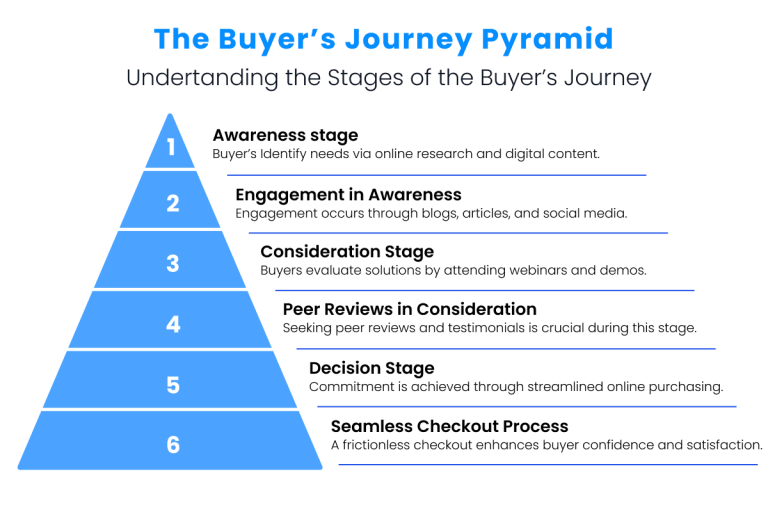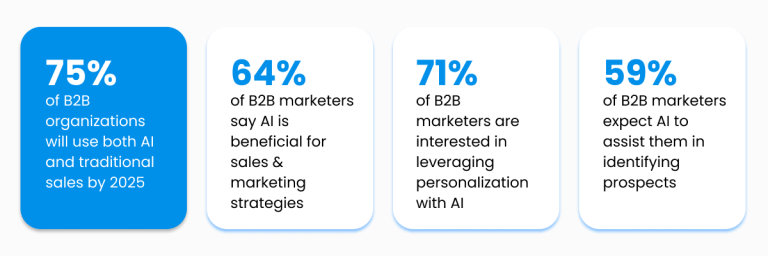Introduction
Gartner’s research reveals that 75% of the B2B buyers prefer a rep-free sales experience, but it also states that self-service digital purchases are far more likely to result in purchase regret.
Enterprises are now striving to strike the right balance of digital and human touchpoints to achieve their desired business goals.
The digital channels facilitate on-demand access and automated assistance which not only gives product information to a buyer but also nurtures them to become sales-ready. A B2B buyer today has become more self-reliant while doing a complete product evaluation, comparative analysis, pricing and availability assessment etc.
What is the B2B buying process?
B2B purchasing is a multi-level process where a business carries out a set of steps to purchase the goods and services from another business. It involves internal needs identification, extensive research on options and their prices, vendor assessment and selection, negotiation of terms and conditions etc. Moreover, it is a collaborative process involving multiple stakeholders, to come to a purchase decision, reviewing after-sale performance and deciding on repeat purchase.
Why is the B2B buying process changing?
B2B purchasing workflow is changing mainly because of readily accessible online information and the increase of digital communication channels between a brand and its potential customers. It supports more reasoned and informed decisions. The expectation of a corporate buyer is now to have a personalized experience which goes beyond product features and fitment value.
What are the key changes in B2B decision-making in 2025?
Insight-Driven Decision Support: Transforming Data into Action
B2B companies are planning their marketing and sales strategies based on real-time insights and predictive analysis on purchase and demand patterns.
Enterprises are majorly moving to CRM platforms, automating their sales processes and core customer journey functions. AI-enhanced sales CRM solutions today help in centralizing contact data management, assessing customer transaction history analysis, tracking purchase behavior and predicting needs and opportunities.
Digital-Powered Analysis
Gartner’s studies indicate that 80% of B2B sales interactions will occur on digital channels by 2025. Another interesting finding from Forrester suggests that Millennials and Gen Z constitute 64% of business buyers, while millennials make up half of all business buyers.
The B2B buying process isn’t linear anymore as the buyers educate themselves with online content now and include other stakeholders along the way. A consultative approach which compliments the buyer’s research with added insights is what many B2B sales strategists are applying today.
The Personalization Imperative: Rising Expectations in 2025
With the available omni-channel communication, through social media, websites, email or chatbots, the B2B decision–making process has become more complex. B2B buyer groups expect customized experiences which address their business challenges.
They prefer to get relevant case studies and tailored recommendations from you for their unique challenges. Leveraging AI/ML driven. Personalized content cuts through the noise by providing exactly what the targeted buyers’ needs.
Collaborative Purchasing Teams
The B2B purchase ecosystem can consist of 6-10 decision-making groups spanning across multiple functions like IT, operations and finance. There can be various metrics for consideration in decision finalization. For example, there can be risk assessment, budget scrutiny, internal alignment etc. It has become more important now than ever for sales teams to navigate through complex sales cycles and deliver personalized value.
Early Vendor Shortlisting
Forrester predicts that more than 50% of large B2B transactions ($ 1M or greater) will be carried out through digital channels, including vendor websites and marketplaces. Business buyers now have access to digital tools, AI-powered actionable insights and peer reviews giving them detailed awareness on the available vendor ecosystem. In B2B tech-purchasing, for instance, including configuration-based product information with customization options and price-related insights is an integral part.
How have the traditional purchase stages transformed today?

What are the challenges of selling to the modern B2B buyer of 2025?
- Informed buyer: Today’s business buyers are well-informed with an abundance of information available to them. They are capable of doing thorough online research and vendor assessment by themselves.
- Complex Decision-Making Unit (DMU): The decision-making of multiple stakeholders who might have different needs, perceptions and apprehensions. A very well-thought nuanced sales approach is required which addresses specific needs.
- Prolonged Sales Cycle: It’s a challenge for B2B companies to consistently communicate with their buyers through different channels and keep the engagement flow seamless without overwhelming them with excess information.
- Targeted Content Creation: Personalized content is prevalent today as B2B buyers are likely to consume content which is relatable to their needs. It can be blogs, case studies, webinars, whitepapers etc.
- Revenue Alignment: Fostering effective collaboration between sales and marketing functions can become difficult when both units need to work towards enhancing customer experiences and converting prospects through the sales cycle.
How can B2B companies Realign and Transform for the modern AI Era of Marketing?
Did You Know?
Content is still the King
As per Sellers Commerce, 60% of the B2B buyers may finalize a purchase decision based solely on digital content.
Here are a few impactful types of content from Sales Commerce:

By creating and distributing valuable content, your company can effectively build trust and credibility. Moreover, you can establish thought leadership in your given industry space. Most importantly, you can attract and nurture intent-based prospects.
Adapt to AI-Powered Analytics & Market Intelligence
Companies are now leveraging AI to analyze big data sets to get predictive insights on customer’s buying behavior, total addressable market, competition analysis etc. Furthermore, AI can assist in effective segmentation by product, geography, industry, customer persona etc.
Adopt Real-time Marketing Automation
AI is now enhancing and automating campaigns for greater productivity and ROI. Large enterprises are using AI to optimize and personalize their email and social media campaigns with content that aligns with individual customer needs. In addition, it analyzes historical and behavioral data and makes relevant recommendations to clients.
Optimize Real-time Interactions with Conversational AI
AI bots can enhance real-time interactions for a more personalized outreach to various buying groups. It is also being used for high probability lead analysis and forecasting conversion probabilities. AI is now being used with higher features where it can be used for real-time pricing strategies and for 3D virtual reality (VR) product demos too.
Accelerating Sales Funnels with Account-based Marketing Momentum
Once again, AI is the common factor in propelling B2B marketing strategies for the modern business buyer. The B2B buying process has changed overtime and AI could be just the right sales assistant for you. It carries out precise customer segmentation as per content consumption, purchase behavior and demographics record.
Tips On How to Use AI as a Catalyst in the New B2B Buying Process
Recent Insights by Business Dasher on AI in B2B Marketing

Conclusion
The need for centralized lead data building, capture and tracking with AI-enhanced integrations is predominant. The key benefits which some forward-thinking B2B organizations are already capitalizing on are:
- Personalization at scale
- Real-time buyer-driven insights
- Informed decision-making
- Optimized Campaigns & Analysis
TSL Consulting, with proven experience of over 20 years, has pivoted more than 1000 marketing and demand generation campaigns for global tech enterprises. Our company has closely monitored the transitions in customer journey and experience in B2B marketing. Our journey continues as we assist tech-driven enterprises of all sizes to upscale lead generation and conversion rates.
Let’s have a short introductory call to explore how TSL can help your business speed up your marketing and sales funnels.
Call us on +91 9529286060 or mail us at smohite@tslmarketing.com
FAQs
How does AI leverage personalized content?
AI analyzes customer behavior, preferences, and historical data to create tailored content recommendations. It automates content distribution across channels while ensuring relevance to individual buyer needs and interests.
How to strategize a collaborative-stakeholder strategy?
Focus on addressing the diverse needs of 6-10 decision-making groups across functions. Create targeted content for each stakeholder, maintain consistent communication, and provide relevant case studies that address specific departmental concerns.
How to build mind share and wallet share with your buyer?
Leverage AI-powered analytics to understand buyer behavior, create valuable thought leadership content, and maintain personalized engagement across multiple touchpoints. Demonstrate industry expertise through targeted content and solutions.
How to handle rejection from multiple stakeholders?
Analyze stakeholder concerns using AI insights, address specific pain points with targeted solutions, and maintain engagement through personalized follow-ups. Focus on building value propositions that align with each stakeholder's objectives.
How has AI transformed the B2B buying process?
AI has enabled real-time analytics, automated personalization, predictive insights, and enhanced customer interactions. It's revolutionized lead scoring, content distribution, and buyer journey mapping while optimizing sales cycles.
What are the benefits of embracing this shift in B2B buying behavior?
Embracing digital transformation leads to improved personalization at scale, data-driven decision-making, optimized campaigns, and enhanced customer experiences. It enables better alignment between sales and marketing efforts.
What are the biggest challenges in selling to modern B2B buyers?
Managing informed buyers, complex decision-making units, lengthy sales cycles, creating targeted content, and maintaining revenue alignment between sales and marketing teams are the key challenges in modern B2B selling.


